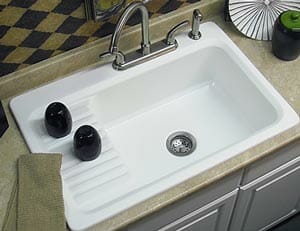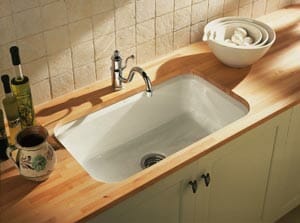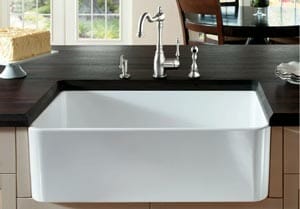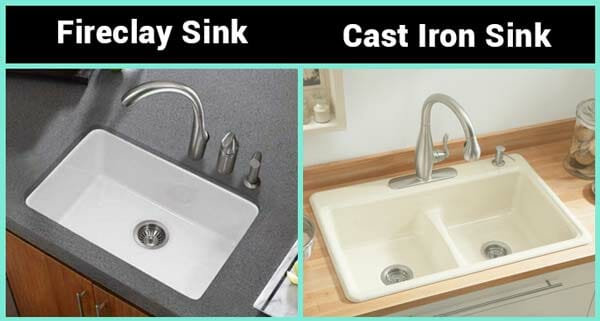SeaRanchLodge.com is a participant in the Amazon Associate program and will earn from qualifying purchases.
A kitchen sink is an essential part of any kitchen and will see a lot of work. When looking to invest in a kitchen sink, you will want to get one that is durable, strong, and easy to handle.
In your search for a good kitchen sink, you are stuck between choosing either a fireclay or cast iron sink since those two are quite popular.
Which one do you choose? This fireclay vs. cast iron sink comparison article will help give you an idea of the differences between the two types of sinks and which one you might prefer. We shall begin by looking at the materials.
For more kitchen tips, check out here.
What Cast Iron?
Cast iron is a common material used to make cookware and often present in many kitchen tools. It is an alloy of iron and carbon, which means it is a mixture of those two elements. The carbon content in cast iron makes it more easier and brittle to mold and work with.
Iron ore is melted in a special type of furnace known as a blast furnace. The crude iron that is produced is remelted along with carbon and limestone with various filtering processes to get cast iron.
This type of iron has been in use for a long time due to its durability and resistance to rust. The cast iron used for kitchen sinks is a bit special as it has a porcelain enamel coating applied to the surface. Porcelain enamel is made by melting powdered glass and then letting it harden.
What is Fireclay?
Fireclay is a type of clay that is resistant to high temperatures. It is used to make firebricks. Fireclay is just normal mud with higher aluminum content. This type of clay is much whiter in comparison. It is usually found much deeper down.
This type of clay is used for kitchen sinks, and although somewhat rarer, it still has its appeal. Fireclay is molded at high temperatures and then left to dry and solidify. To make it stronger, similar to cast iron sinks, porcelain enamel is applied.
Fireclay Vs Cast Iron Sink: What Is The Key Differences?
1. Installation
After having understood a bit about the materials used to make them and how they are made, we can now look at the various qualities of the two sinks and how they prepare. First and foremost, let us look at how the sinks differ in regards to installation.
Cast Iron:
Cast iron sinks are strong and durable, but this also tends to make them much heavier. This can make them difficult to handle and install, especially without professional help.
Since they are widely available, they have different installation options. These include drop-in, undermount, and apron front. Each model has different advantages and disadvantages.
Also Read:
Drop-In Models

Drop-in, as the name suggests, consists of sink models with a rim that is installed on top of the countertop. They are dropped in making sure there is enough space for it to fit and are generally the easiest to install.
The only problem with a drop-in iron cast sink is that unless it is a perfect fit, you’ll end up with some gaps between the countertop and sink. These often look bad and can affect your sink, so you need to seal them.
Undermount Models

Undermounts do not have the sealing issue as they are installed under a countertop. However, they can be difficult to install, and considering the weight of the sink, you will need additional support to hold it in place.
Apron Front Models

Apron front sinks are unique in design and have an exposed sink front. While this makes them easier to install compared to undermounts, not all kitchen cabinets will be designed to allow them to be installed. If you want them, you might need to redesign your kitchen.
While cast iron sinks have different installation methods, they have their fair share of troubles, and it is recommended to seek professional help for installing them. At the very least, you should have a helping hand to deal with the weight.
Fireclay Sinks:
Fireclay sinks weigh comparatively less compared to their cast iron counterparts. As a result, they are much easier to handle and often do not require undermount support. They feature similar models and installation methods, but even though they are lighter, you still should have someone help you out during installation.
2. Cost:
Next, we shall look at how the two sinks differ in terms of cost.
Cast iron sinks tend to have a wide price range since there are a variety of factors. This includes size and model. A rough estimate of a price range can be around anywhere from 300 dollars to 700 dollars. Some cast iron sinks can go low as 200 dollars, particularly on sales.
Since fireclay sinks go through a more extensive manufacturing process, they tend to cost more. On average, their prices start at 600 dollars in contrast to cast iron sinks. These prices can reach 1000 dollars, too, depending on sink capacity and how well it was made.
So it can be seen that cast iron sinks are much cheaper options compared to fireclay sinks.
3. Resistance to Rust and Durability
Next, let’s see how durable the two sinks are in comparison.
Cast iron sinks are quite durable and have been known to last for long periods. The enamel coating is also key in protecting the cast iron sink from rust.
However, the enamel layer can be chipped off by force or sharp objects. This can result in scratches on the sink’s surface, which can expose the iron underneath. This will not only make it look bad but will also make it susceptible to rust.
Despite fireclay sinks being lighter, they have similar levels of durability to cast iron sinks. Contrasting their cast iron counterparts, they are harder to chip off and, as a result, not as susceptible to rust.
As you can see, both sinks offer similar levels of durability, but fireclay sinks have a greater resistance to rust and are easier to maintain.
4. Ease of Cleaning
The two sinks do have different measures of cleaning that you should be mindful of.
When you using cast iron sink one thing you should remember about cleaning cast iron sinks is that you should avoid using abrasive cleaners. This can damage the enamel coating and leave the iron exposed. Other than that, cast iron sinks don’t have any other restrictions for cleaning.
Fireclay sinks don’t have any problems with abrasive cleaners and are much easier to clean and maintain compared to cast iron sink.
5. Color and Aesthetic
While this point is mostly subjective, both sinks have a different style and appeal to them, and users of different sinks can vouch for it.
Cast iron sinks have an enamel coating and thus have a very polished look. They come in a variety of colors and can make it easier to find a sink that goes well with your kitchen’s look.
Fireclay’s type of sink doesn’t come in such a variety of colors like cast iron sinks and doesn’t have such a polished look to them. Fireclay sinks often come in white, and if you are worried about matching aesthetics, it might be difficult to make your fireclay sink look good.
Conclusion
Both types of sinks are good choices for your kitchen, and often, it’s a matter of preference. If you’re using a cast iron sink, remember to be careful. And if you’re using a fireclay sink, be mindful of the prices since they can be expensive. We from Sea Ranch Lodge, hope that our guide on cast iron vs fireclay sink will help you to the right decision choosing between them.
Other Kitchen Related Article:


